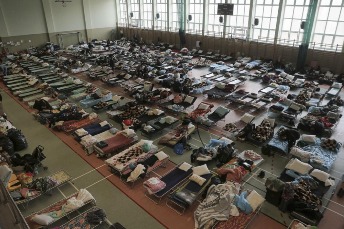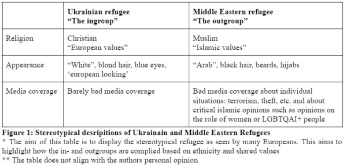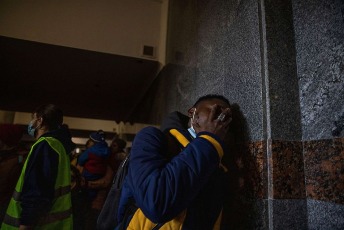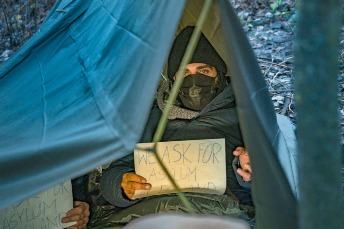Students Diving into Diversity: A Series of Blogs and Podcasts from the DEI Forum

A very warm welcome to the series of blogs and podcasts from the Diversity, Equity and Inclusion (DEI) Forum! We have collaborated with a Responsible Humanity Major course ‘Psychology of Culture and Diversity’ in which student writers have beautifully connected the social psychological theories to real-life events of prejudice. This week we are sharing the event analysis by Lisa Cockx which discusses the treatment of Ukrainian refugees in Europe.
If you have any questions, please reach out to one of the students who have taken this course in the Global Responsibility and Leadership programme or to the DEI Committee. The DEI Committee represents the DEI Forum, a group of students and staff aiming to promote DEI in our community. Look out for more exciting blog posts and podcasts in the coming weeks!
This week: “The double standards of refugee treatment. Ukrainian vs. Middle Eastern Refugees in Europe” by Lisa Cockx

The territorial conflict between Russia and Ukraine began on February 20th, 2014 and recently escalated into a still-ongoing war. The first full-scale invasion against Ukraine happened on February 24th, 2022, following a months-long military-force buildup by the Russian army close to Ukraine. The conflict's status is categorised as worsening, and by now, 2,5 Million refugees (around 5,6% of the total population) have been registered as fleeing Ukraine since the start of the escalated conflict. Mostly women and children are fleeing , as men are required to stay in the country to fight in the war. The nearby European countries are greeting Ukrainian refugees with open arms. A total of 1,66 million refugees arrived in Poland, the remaining one million split up mainly to go to Slovakia, Hungary, Romania, the Republic of Moldova and Russia. This overall positive reaction towards refugees fleeing war is relatively new for these European countries, when compared to the position these countries h ave taken towards the ongoing Middle Eastern refugee wave from 2015. Just a few years ago, countries such as Poland refused to take in refugees and did not meet the official requirements following the Dublin Agreement for Refugee Distribution .
This social conflict thereby involves threats to human well-being, involving Ukrainian and Middle Eastern refugees as well as inhabitants of European nations. Here, I will provide an informed analysis to tackle the question of why these double standards in refugee treatment exist. I will do this via the lens of social psychological theories of intergroup relations, namely the social categorization theory and the gendered outgroup prejudice.
A Manifestation of ‘Us-versus-Them’ Mindset

The social categorization theory by Tajfel (1971) describes a person's tendency to categorise individuals into groups, themselves included. Thereby, in- and outgroups, ‘us’ and ‘them’ emerge. People then tend to be more positive towards ingroup members , and show elevated levels of greediness towards the outgroup . As expected, people will thereby work harder and be more open to helping members of their ingroup . We can see that the Ukrainian refugees are seen as the ingroup by the Europeans, whereas the Middle Eastern refugees are perceived as the outgroup (Figure 1).
Edward Said’s Orientalism theory supports the likelihood of this categorization, as the Middle East is seen as a very different culture that is often connected to imaginary danger. his way of thinking, combined with media representation, completes this.
image of Middle Eastern people as ‘the other’. And media representation of Ukrainian refugees that describes them as ‘looking like us’, ‘being European’ helps create the picture of those refugees belonging to the ingroup. This differentiation becomes especially clear as the beneficial behaviour towards members of the ingroup more strongly applies to members that are typical of the ingroup . This tendency to socially categorise people as ‘us’ versus ‘them’ has an evolutionary origin too. Historically speaking, whenever
people came into contact with people of other ethnicities, the encounters used to be hostile and threatening , therefore, humans developed an unconscious mechanism o f detecting the type of encounter that is likely to occur, and to quickly identify others’ coalitionary status which oftentimes could be gleaned from the outer appearance of the stranger . Moreover, like a smoke alarm detector, the psychological mechanisms have developed towards being more negatively biassed as a default option, as in this case, being wrong has fewer negative consequences for the individual.

As the current situation shows, Europeans seem to be more prejudiced towards refugees from the Middle East. This different treatment of the public towards the refugees from Ukraine compared to Middle Eastern refugees, even though both groups are war refugees, becomes especially apparent when focusing on ethnicity rather than the country that they are fleeing from. People of colour, mainly African students , fleeing Ukraine are facing heavy discrimination and racism , up to the point where they are denied access to trains or to crossing borders . The race-based social categorization could explain why people of colour fleeing from Ukraine are treated significantly worse than Ukrainian refugees who have a more stereotypical European appearance.
Or could it be an issue of “Gendered Outgroup Prejudice”?
Nevertheless, it could be argued that the assumption that most Ukrainian refugees are considered part of the ingroup by Europeans, is incorrect. For this, we assume that refugees, no matter their origin and ethnicity, are the outgroup. But then why would the groups still be treated so differently? The answer could lay in the majority gender of the refugee groups. Most refugees from Ukraine are women and children , whereas 73% of refugees from the Middle East were men. Indeed, different prejudices depend on the gender of the outgroup member . This has to do with the expected threat that can come from the outgroup individual, as men are perceived to pose a greater threat than women .
What can we conclude from this analysis? And how do I personally think about this double standard?

The frameworks of the social categorization theory and gendered outgroup prejudice theory were applied to understand why we are facing such a double standard of refugee treatment between Ukrainian and Middle Eastern refugees in Europe. Both theories converge on the idea that there is an ingroup and outgroup and that a certain potential threat can be expected from members of the outgroup. From the perspective of social categorization theory, the differential treatment can be explained by the observation that Ukrainians are seen as the ingroup by Europeans, whereas Middle Eastern refugees were in the outgroup. From the perspective of the second theory, this assumption was overridden, leaving us with the idea that all refugees, regardless of ethnicity and country of origin, are considered the outgroup. Then, the double standard could be explained with the prevailing gender of the two groups.
To conclude, refugees, in the case of both models, are categorised as ‘potentially dangerous’ and ‘likely not dangerous’. The Ukrainian refugees, mostly women and children, are perceived to be less of a potential threat than the Middle Eastern refugee groups, which consist majorly of men. This is either because of their gender or because they are more ‘European’ and thereby in the ingroup. In summary, these are aspects to think about, particularly in combination with the manner these groups are presented in the media, which risks exacerbating this perception.
Personally, I disagree with the different treatment of refugees. Every war refugee has a legitimate reason why they fled and in my opinion, they should all receive the same treatment and be greeted with open arms, no matter where they come from or what gender they express themselves as.. An informed psychological analysis and attempts to understand why a certain injustice may have occurred does by no means justify or legitimise any injustice and unequal treatment of human beings.
Not that I claim my readers are biassed, but maybe this attempt to understand the reasons for this particular bias can encourage you in reflecting on your own personal biases (if any), identifying where they might be coming from, and this might help you to overcome them.

